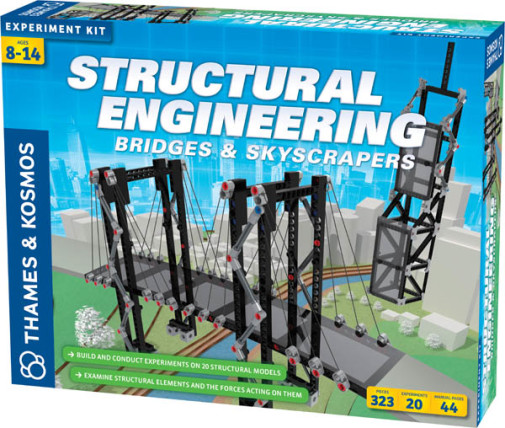We use cookies to make your experience better. To comply with the new e-Privacy directive, we need to ask for your consent to set the cookies. Learn more.
Structural Engineering: Bridges & Skyscrapers
Skyscrapers stand tall without falling over. Bridges span great distances without collapsing. Introduce your inquisitive children to the forces of physics and structural elements that create magnificent structures. Beginning with small models, children will learn about basic structural elements including columns, beams, trusses, plates, arches, shells and catenary. Explore forces such as tension, compression, shear and torsion before moving into more complex models of trusses, roofs and small buildings. They will also experiment with different types of bridge constructions: truss, arch, suspension and cable-stayed bridges. Material strength and stiffness are investigated as they learn how structural engineers maximize safety and minimize cost at the risk of structural failure. Full color lab manual includes step by step illustrated directions to complete 20 experiments in 3 levels (easy, medium and hard), vocabulary definitions, "Did You Know" and "What's Happening?" explanations, and more. 44 pages total. Kit includes 323 pieces. Bring STEM alive to your children with this quality Thames & Kosmos experiment kit! ~ Deanne
Do you ever wonder how bridges span huge distances and how skyscrapers stay standing? Structural engineers use physics and their knowledge of the properties of building materials and geometric shapes to design structures with sufficient strength and stability.
With this kit of modular building pieces, you can learn the basics of structural engineering by conducting a series of 20 model-building experiments. Each model demonstrates a basic principle of mechanical physics or structural engineering in a hands-on way.
Start out with small models that demonstrate how structural elements can be attached together to maximize the strength of a structure for a fixed amount of material used. Learn about basic structural elements including columns, beams, trusses, plates, arches, shells, and catenary. Explore the forces acting on structural components including tension, compression, shear, and bending.
Move onto building more complex models of trusses, roofs, and small buildings. Experiment with different types of bridge construction: a truss bridge, arch bridge, cantilever bridge, rope bridge, and suspension bridge. Finally, build models of towering skyscrapers. What is the tallest tower you can build using only the pieces included in the kit?
Learn about the strength and stiffness of materials. See how structural engineers optimize factors to maximize safety, and minimize cost and the risk of structural failure.
A 44-page, full-color manual guides you through model building with step-by-step illustrated instructions.


My son is very hands on and is amazing at building with his legos. He's already completed 12yo lego model building at age 6, now that he's 7yo, I wanted to go a different route and expose him to…
To begin studying engineering
Seems interesting
My boys like putting things together and learn from this kind of thing.